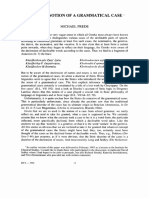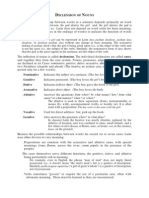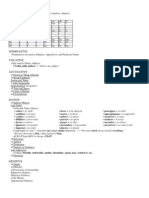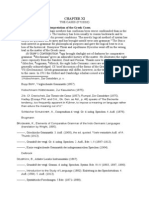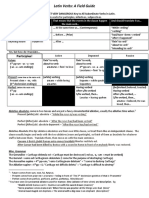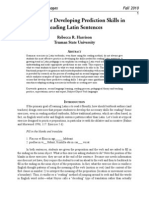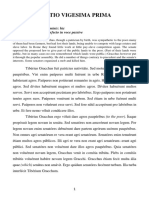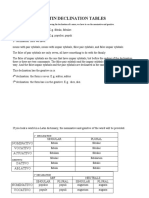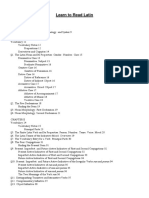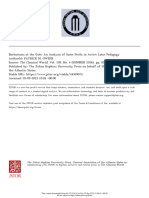Il Settimo Caso
Uploaded by
Letizia DelnevoIl Settimo Caso
Uploaded by
Letizia DelnevoJournal of Latin Linguistics 2017; 16(2): 239–266
Javier Uría*
Septimus casus: the history of a
misunderstanding from Varro to the late
Latin grammarians
https://doi.org/10.1515/joll-2017-0011
Abstract: This paper reviews approaches to what is known as the septimus casus
from Varro and Quintilian to the late grammarians. It emphasizes the different
points of view adopted to describe the seventh case in the history of Latin
grammar, and suggests that some descriptions have arisen from simple misin-
terpretations of earlier sources. The paper confirms that Varro may have had a
concept of a seventh case. Interestingly, an unnoticed connection has been
detected between the earliest approaches and those in Servius’s commentaries
on Vergil, where the opinion differs greatly from those in the artes grammaticae.
Keywords: Quintilian, Varro, septimus casus, ablative, Latin grammarians,
ancient linguistics
1 Introduction
de septimo autem cassu quid dicemus, cum tam multi de eo scribserint, ut iam nullum certius
sit (Virg. gramm. epit. 5, p. 36, 7)
The septimus casus was a matter of debate in ancient Latin grammar from at
least a generation before Quintilian until the end of the tradition in the monu-
mental Institutiones grammaticae by Priscian. In between, divergent (and often
contradictory) definitions and examples were provided by the late Latin gram-
marians. Modern scholarship soon detected the controversial nature of the label
septimus casus, and a rich stream of discussion can be seen from the nineteenth
century to recent times. In both ancient and modern scholarship, the prevalent
view was gradually imposed that septimus casus should be described in opposi-
tion to the prepositional phrase ab plus the ablative.
This paper aims at a historical reexamination of the issue of the septimus
casus. By taking a fresh look at Quintilian’s approach (inst. 1, 4, 26), and by
*Corresponding author: Javier Uría, Departamento de Ciencias de la Antigüedad, Universidad
de Zaragoza, Ciudad Escolar s/n, 44003 Teruel, Spain, E-mail: juria@unizar.es
Brought to you by | Universita Studi di Torino
Authenticated
Download Date | 2/21/19 9:53 AM
240 Javier Uría
considering a hitherto unnoticed parallel passage, it can be established that the
later grammarians’ view on the subject partly stems from a plain misinterpreta-
tion of earlier sources, a misreading that occurred almost right before our eyes.
It is also possible that Varro had detected the polysemy of the Latin ablative, so
that at least the idea of a seventh case, if not the term, was felt long before
Quintilian. Finally, it can be observed that the view in the grammatical com-
mentaries of the septimus casus seems closer to the original approach than to the
wrong developments in the late grammarians.
2 Status quaestionis
Steinthal’s (1891: II 266) influential work already contained the statement that
the ablative with a preposition had been distinguished from the simple ablative,1
especially the one with an instrumental2 meaning, to judge from Quintilian’s
example (hasta percussi). Steinthal relies on Claussen (1873: 377–378) where
some of the crucial texts ([1]–[4]) are provided in a selection that has determined
the most widespread interpretation of the facts:
(1) (Quint. inst. 1, 4, 26)
Quaerat [scil. praeceptor acer atque subtilis] etiam sitne apud Graecos uis
quaedam sexti casus et apud nos quoque septimi. Nam cum dico ‘hasta
percussi’ non utor ablatiui natura, nec si idem Graece dicam, datiui.
(2) (Don. gramm. IV 377, 20–24)
quidam adsumunt etiam septimum casum, qui est ablatiuo similis, sed sine
praepositione ab, ut sit ablatiuus casus ‘ab oratore uenio’, septimus casus
‘oratore magistro utor’.
(3) (Char. gramm. p. 195, 17–21)
adicitur a diligentioribus etiam septimus casus. ubi enim a re aut loco dicimus,
ablatiuo utimur; ubi autem ‹in re aut loco› dicimus, septimo magis casu utimur.3
1 Steinthal relies on Claussen (1873: 378), who explicitly compares Quintilian’s passage with
those in Donatus, Charisius and Diomedes (see texts below).
2 This label will be used for convenience throughout this paper. The notion of ‘instrument’ is
very close to that of ‘cause’, ‘force’ and ‘means’. For all these notions relating to the ablative
case in Latin, the reader is referred to Luraghi (2009).
3 The phrase in re aut loco is supplied from the parallel passage in the Anonymus Bobiensis. On
that amendment, see Section 5 of this paper.
Brought to you by | Universita Studi di Torino
Authenticated
Download Date | 2/21/19 9:53 AM
Septimus casus: the history of a misunderstanding 241
(4) (Diom. gramm. I 317, 17–34)
ceterum ab his quidam discrepant qui etiam septimum casum adsumunt,
qui est ablatiuo similis, ratione autem non congruit, cuius differentiam
inserere haud piguit ita. casus ablatiuus praepositiones semper recipit et
uno modo profertur, cum a persona ablatum quid significetur aut a re aut a
loco, cuius uis apud Graecos bipertita est […] septimus uero casus his
praepositionibus quae ablatiuo casui conueniunt subtractis profertur
modis quattuor.
(5) (Prisc. gramm. II 190, 2–5)
illud quoque non est praetermittendum, quod quibusdam septimus casus
esse uidetur ablatiuus, quando sine praepositione profertur, quod satis
irrationabile uidetur; minime enim praepositio addita uel detracta mutare
ualet uim casus.
Undeniably, even from the critical approach of a Priscian, the conclusion can
be drawn that the septimus casus was generally defined as an “unpreposi-
tional” ablative. And this is indeed the accepted view by most of the ancient
grammarians and the modern critics. Among the former, there is explicit
reference to the preposition in, e.g. Donatus (2), Diomedes (4), Priscian (5)
and Consentius (6):
(6) (Consent. gramm. V 351, 12–16)
et in tantum recte hunc casum additum constat, ut etiam septimum casum
usus nostri sermonis exposcat, qui septimus casus ablatiui formam habet,
sed praepositione subtracta.
As for modern scholarship, the “prepositional interpretation” is accepted in the
important works of Jeep (7) and Barwick (8):
(7) (Jeep 1893: 137)
Ausser den sechs Casus wurde von manchen noch ein septimus casus
angenommen und zwar, heisst es bei einigen Grammatikern ganz charak-
teristisch, ‘a diligentioribus’. Der ablativus wurde dann eng aufgefasst als
der casus, welcher allein das ‘a persona aut a loco aut a re ablatum’
bezeichnete und die entsprechende Präposition bei sich hatte.
(8) (Barwick 1922: 165 n. 1)
Ebenso waren es syntaktische Gründe, die den Palaemon zu seiner
Unterscheidung zwischen ablatiuus bzw. septimus casus geführt haben.
Brought to you by | Universita Studi di Torino
Authenticated
Download Date | 2/21/19 9:53 AM
242 Javier Uría
It is important to note that Barwick takes the approach found in the late
grammarians back to Remmius Palaemon, i.e. to a generation before
Quintilian, without balancing the (very different) approach by Quintilian him-
self. This proves to be a methodological error, as shown later in this paper.
That Quintilian’s view of the problem was different from the one in later
grammar handbooks was noticed by Schreiner (9), even if he seems to accept
Barwick’s proposal on Palaemon:
(9) (Schreiner 1954: 64)
Palaemon zweigte aus syntaktischen Gründen vom Ablativ den septimus
casus ab. Nach Quintilians Formulierung und Beispiel: cum dico „hasta
percussi“ non utor ablativi natura scheint es fast, als habe er die instru-
mentale Natur des septimus casus schon erkannt. Soweit die späteren
Grammatiker diesen gelten lassen, beschränken sie sich teilweise auf die
Feststellung, daß der Ablativ mit einer Präposition, der septimus casus
ohne solche stehe.
Schreiner describes as a restriction (“beschränken sie sich”) what was actually a
misinterpretation, as will be shown below, and he does not try to account for the
doctrinal difference.
Interest in the septimus casus is also observed among scholars working on
Latin linguistics. Largely unknown, a brief study by Bartonĕk (1956) details
seven interpretations of the septimus casus since the time of Quintilian.4 The
study in Calboli (1972: 105–110), which draws from Barwick (1922), establishes
three different explanations for the septimus casus: (i) the septimus is distin-
guished from the ablative because of the preposition the latter takes; (ii) there
are four different meanings of the septimus casus: (a) in + ablative (in Scipione
militaris uirtus enituit); (b) ablative absolute (ducente dea); (c) the construction
spe posse ( = Greek ἐλπίδι τοῦ δύνασθαι); (d) ablative absolute with no participle
(nullo timore hostium); (iii) the septimus casus can be explained through per +
accusative. Explanation number (i) is given by the Donatus group; number (ii)
by the Charisius group, and number (iii) is found in Ps. Asper and Marius
Victorinus.
4 They are stated as follows in the English abstract at the end of the paper (Bartonĕk 1956: 181–
182): 1. septimus est, ubi in re aut loco dicimus, non a re aut loco (Charisius). 2. s. fit praeposi-
tionibus quae ablatiuo conueniunt subtractis (Diomedes, Dositheus). 3. s. est ablatiuus sine
praepositione ‘ab’ (Donatus). 4. s. est ablatiuus sine praepositionibus (others not named here).
5. s. fit duobus ablatiuis pariter copulatis (Sacerdos). 6. s. per accusatiuum liquidius explicatur
(type ‘terra uehi’) – Maximus Victorinus, Audax, ‘Asper’).
Brought to you by | Universita Studi di Torino
Authenticated
Download Date | 2/21/19 9:53 AM
Septimus casus: the history of a misunderstanding 243
After Calboli, a series of papers addressed the issue, either specifically or in
connection with the ablative. Soon after Calboli (and independently), Iso
Echegoyen (1975) analyzed the use of the label ablatiuus in the artes gramma-
ticae, and, having observed that all the examples of ablatiuus take the form of
ab + ablative, he concluded that the term must be identified with the phrase ab
+ ablative: “los gramáticos latinos reservaron el término ablatiuus no a un caso,
sino a un sintagma preposicional” (Iso Echegoyen 1975: 39–40); he argues that
this must be true from the beginning (“desde su acuñación”), and invokes
Quintilian 1, 4, 26 (1):
(10) (Iso Echegoyen 1975: 40)
En este pasaje queda bien claro que si hasta (septimus casus) no tiene la
naturaleza de “ablativo”, el sextus casus (i.e. ablativus) del que carece el
griego ha de consistir en un giro preposicional; y si Quintiliano coincide
con los gramáticos posteriores en lo esencial, es decir, en definir ablativus
a un nivel sintagmático y no paradigmático, no parece muy aventurado
suponer que para nuestro autor dicho “caso” consista en a(b) + nuestro
ablativo.
Another Spanish scholar, García Fuentes (1978), draws heavily from Calboli and
accepts Barwick’s assumption about the syntactic difference between the abla-
tiuus and the septimus; she also holds that the “septimus casus se distingue del
ablativo por la ausencia de preposición de la que el ablativo está acompañado”
(García Fuentes 1978: 314).
In two slightly different versions of the same paper,5 Murru (1980a, 1980b)
proposes that the septimus casus is presented by the Latin grammarians as
including every use of the ablative “que n’est pas ramenable à l’acception
élative (donc aussi étymologique) de l’ablatif joint aux prépositions a, ab, e,
ex, de” (Murru 1980a: 152). However, even if Murru (1980a: 153) seems to
perceive that they are primarily thinking about the “emploi élatif” when refer-
ring to the prepositional ablative, he does not explore this intuition further; on
the contrary, in another paper he speaks about the seventh case as the “ablativo
privo di preposizioni (spesso con valore strumentale)” (Murru 1982: 262).
On similar lines, Baratin (1989) thinks that the septimus casus “serait
présenté de façon négative” (Baratin 1989: 331) in relation to the ablative
sensu stricto, which was “caractérisé au moyen de deux critères, l’un syntaxique
5 It is remarkable that in one of them (Murru 1980b) there is a reference to Calboli (1972), which
is not taken into account in the other one (Murru 1980a), which instead refers to Bartonĕk
(1956).
Brought to you by | Universita Studi di Torino
Authenticated
Download Date | 2/21/19 9:53 AM
244 Javier Uría
(l’ablatif se construit avec une préposition), l’autre sémantique (il correspond
aux notions de provenance et de séparation, disons globalement à la notion
d’origine)” (Baratin 1989: 331). Serbat (1994) explores the issue of the septimus
casus by emphasizing the disparate uses assigned to this case, which is opposed
to the proper ablative (ab + ablative); but he ignores the studies of Barwick and
Calboli, wrongly considering Scaurus (instead of Palaemon-Quintilian) “le plus
ancien témoin cité par nos documents” (Serbat 1994: 169).
The most recent overall approach to the septimus casus by Milani (2004) is
better informed. By drawing largely from Calboli (1972), Milani extends the
evidence beyond Priscian by including passages from Iulianus Toletanus
(seventh century), Papias (ninth century) and Petrus Helias (twelfth century).6
She is right in showing perplexity about opinion in the Charisius group relating
to in + ablative as a septimus casus (Milani 2004: 17).
Before Milani, some attention had been paid to the seventh case by Sluiter
(2000), who draws from Murru to conclude that the term septimus casus was
coined “for all those cases in which the ablative does not indicate separation or
removal […]. The term also came in use to indicate an ablative without a
preposition (a syntactic consideration, therefore)” (Sluiter 2000: 381).
Overall, modern scholarship on the septimus casus acknowledges the con-
troversial (even contradictory) approaches to the topic by the Latin grammar-
ians, but there is no attempt at a concrete explanation, even if some general
factors are mentioned in that regard: the polysemy in the Latin ablative, the fact
that a Greek rule was not available for the ablative (Calboli 1972: 109; Milani
2004: 17), and the “incapacité metalinguistique de theórisation original et
autonome des grammairiens latins” (Murru 1980a: 151).
In the following pages, we will try to give a more tangible elucidation of the
divergent approaches to the topic observed in the Latin grammarians by first
clarifying the first of the preserved approaches: Quintilian’s.
3 Quintilian on the seventh case
Quintilian deals with the seventh case in a passage in the grammatical chapters
whose full comprehension demands an understanding of the context. After some
paragraphs on phonetics and orthography (Quint. inst. 1, 4, 6–17), Quintilian
goes into proper grammatical matters by exposing the problem of the partes
6 A more complete review of the septimus casus in early medieval sources can be read in
Carracedo Fraga (2006: 20–25).
Brought to you by | Universita Studi di Torino
Authenticated
Download Date | 2/21/19 9:53 AM
Septimus casus: the history of a misunderstanding 245
orationis (1, 4, 18–21). Then he says that children should first learn the declen-
sion of nomina and uerba (1, 4, 22), and reviews the most relevant “accidents”:
as for gender (1, 4, 24), he recommends explaining not just the obvious mascu-
line, feminine and neuter, but also the epicene and those names whose form
may lead to confusion, such as Murena (a masculine with feminine form) and
Glycerium (a feminine with neuter form). Then comes an etymological excursus
on proper names (1, 4, 25–26), and this could have caused the omission of
number, since Quintilian proceeds to cases: he again recommends discussion
of a controversial issue, the septimus casus (1, 4, 26), which could be related to
previous examples as follows: as Murena is apparently feminine, hasta is
apparently ablative. Examples of deceptive forms are given in the following
paragraphs (1, 4, 27–28), dealing with verbs: fraudator could be either a noun
or a verb, whereas tectum and sapiens could be either participles or nouns; also,
the ending –tur may indicate either the passive voice or the impersonal.
In short, all the examples show one or another form of real or apparent
polysemy/homonymy. This allows comparison with another (very significant)
passage by Quintilian that has not been dealt with in relation to the septimus
casus. This passage comes from the part of book 7 where amphibolia is dealt with7:
(11) (Quint. inst. 7, 9, 10)
Accusatiui geminatione facta amphibolia soluitur ablatiuo, ut illud
‘Lachetem audiui percussisse Demean’ fiat ‘a Lachete percussum Demean’.
sed ablatiuo ipsi, ut in primo diximus, inest naturalis amphibolia: ‘caelo
decurrit aperto’: utrum per apertum caelum an cum apertum esset.
All editions and commentaries consulted unanimously compare this passage
with that in book 1 where the homography of the nominative and the ablative is
implied:
(12) (Quint. inst. 1, 7, 3)
ut ‘malus’ arborem significet an hominem non bonum apice distinguitur,
‘palus’ aliud priore syllaba longa, aliud sequenti significat, et cum eadem
littera nominatiuo casu breuis, ablatiuo longa est, utrum sequamur plerum-
que hac nota monendi sumus.
However, this assumption is wrong, as can be demonstrated with two arguments:
(i) the amphibolia in caelo decurrit aperto is intrinsic (naturalis), and (ii) it remains
7 On the general relation of this chapter with the treatment of grammatical homonymy in book
1, see my paper in the previous issue of this volume (Uría 2017).
Brought to you by | Universita Studi di Torino
Authenticated
Download Date | 2/21/19 9:53 AM
246 Javier Uría
within the ablative itself (ablatiuo ipsi), so that no other case form is implied. Of
course, the correct internal reference in passage (11) is not (12), but rather the
passage in book 1 where grammatical homonymy is dealt with, namely (1).
The (now) obvious link between passages (1) and (11) has crucial consequences
for the history of the seventh case, since it allows us to see that by Quintilian times
the septimus casus was very likely not restricted to the instrumental (hasta
percussi), but extended at least to the prosecutiuus (per apertum caelum) and the
absolutus (cum apertum esset); it can also help to reject the view that the septimus
was necessarily opposed to a prepositional ablative. Closer attention to the
example caelo decurrit aperto is needed to confirm these assumptions.
The example at issue recalls Verg. Aen. 5, 212 pelago decurrit aperto, and the
view is taken that Quintilian “[e]ither quotes Vergil from memory, or the line is
from some other poet” (Russell 2001: 285 fn. 13). But the possibility can be
considered that Quintilian consciously altered the Vergilian phrase to serve his
purposes. This is suggested by the fact that Quintilian does not gloss over the
most obvious interpretation of caelo decurrit aperto, which is the one with an
ablative sensu stricto: ‘runs down from the clear sky’. The elative meaning of the
ablative is found in Vergil in combination with decurrere both with and without
the preposition:
(13) (Verg. Aen. 2, 40)
Laocoon ardens summa decurrit ab arce
(14) (Verg. Aen.11, 490)
fulgebatque alta decurrens aureus arce
Both arx and caelum, because they express high places, can easily (more easily
than pelagus) trigger the ablative meaning, especially when combined with a verb
with an elative prefix.8 That is why Quintilian did not feel the need to include the
(most obvious) elative interpretation arising from his reading caelo (for pelago).9
Whatever the reason (conscious or unconscious), we cannot hold that the elative
interpretation of decurrere caelo was rejected by Quintilian. On the contrary, it is
the most obvious implied interpretation, making the other two – so to say –
8 For convenience, this term will be used throughout this paper to refer to the separative
meaning of the ablative (ablative proper, ablative of separation).
9 Interestingly, Fratantuono and Smith (2015) suggest that Quintilian’s caelo is due to “the
influence of the following simile of the dove” (Fratantuono and Smith 2015: 290). They also
propose to read pelago as an elative ablative, arguing that the back part of the race towards the
land was pictured by the Romans as a descent.
Brought to you by | Universita Studi di Torino
Authenticated
Download Date | 2/21/19 9:53 AM
Septimus casus: the history of a misunderstanding 247
alternative. It is not by chance that those two alternative interpretations are given
by Servius in a similar passage, in which the verb (inuehere) does not suggest the
elative meaning of the ablative:
(15) (Serv. Aen. 1, 155)
CAELOQVE INVECTVS APERTO non per caelum uectus, sed caelo iam sereno
uectus per maria.
What conclusions can be drawn from the parallel passage in Quintilian? Firstly,
the septimus casus is addressed in contexts implying some sort of ambiguity.
Secondly, the relationship between (1) and (11) allows rejection of the assump-
tion that the septimus casus is opposed to a prepositional ablative; instead it is
opposed to an elative ablative, but without a preposition. Thirdly, we can firmly
believe that in Quintilian’s view the septimus was not restricted to the mere
instrumental ablative (hasta percussi), but it also included the prosecutive
ablative and the ablative absolute.
If this new interpretation is contrasted with the information that later gram-
marians give on the septimus casus, some interesting remarks can be added:
1. Explanation number (iii) in Caboli (1972), namely the equation of the
seventh case with per + accusative (terra marique, provided by Marius
Victorinus, Audax and Ps.-Asper), can now be traced back to the times of
Quintilian and, therefore, it cannot be deemed a later misinterpretation.
2. The ablative absolute must have been part of the septimus casus from at
least Quintilian times.
3. The equation of the septimus casus with an ablative without preposition
opposed to ab + ablative is not deduced from Quintilian in any way, so it is
very probably a later misinterpretation.
Before trying to explain some of the questions raised by these remarks, we need
to look at an interesting passage in Varro that has been connected with the
septimus casus.
4 Varro: a septimus casus “avant la lettre”?
Calboli (1987, 2001a) has consistently defended that consciousness of the
seventh case, i.e. of values of the ablative different from the elative, is implied
in a long-debated passage of Varro, in which amendment had veiled the real
meaning. Since there is much controversy regarding the text, it seems
Brought to you by | Universita Studi di Torino
Authenticated
Download Date | 2/21/19 9:53 AM
248 Javier Uría
Figure 1: Mediceus Laurentianus 51.10, fol. 18r, lines 18–22 (Calboli’s transcription).
appropriate to present first the transcription (as in Calboli 1987: 130, Figure 1) of
the relevant part of fol. 18r of the Mediceus Laurentianus 51.10.10
The passage has been edited with acceptance of a reading proposed in the
editio princeps by the fifteenth-century scholar Pomponius Laetus, according to
whom the sequence q quę11 in the third line of the transcription above must be
read as qui‹n›que. Modern editors, to counteract the fact that six cases are
actually listed,12 guessed a lacuna after quinque and supply either sunt qui sex
uelint/putent or sunt qui sex esse uelint (details in Dahlmann 2003 [1940]: 79;
Calboli 1987: 128–130). The resulting text is as follows (we reproduce Calboli’s
adaptation of the text printed in Dahlmann 2003 [1940]):
(16) (Varro ling. 8, 16)
Propter eorum qui dicunt usum declinati casus, uti is qui de altero diceret
distinguere posset, cum uocaret cum daret cum accussaret, sic alia eiusdem
discrimina quae nos et Graecos ad declinandum duxerunt, sine controuersia
sunt qui‹n›que; ‹sunt qui sex putent›: quis uocetur ut ‹H›ercules, quemadmo-
dum uocetur ut ‹H›ercule, quo uocetur ut ad ‹H›erculem, a quo uocetur ut ab
‹H›ercule, cui uocetur ut ‹H›erculi, cuius uocetur ut ‹H›erculis.
The traditional interpretation of the passage was that the six cases consid-
ered were nominative, vocative, accusative, ablative, dative and genitive.
Five of them were cases without discussion (sine controuersia), whereas one
10 Courtesy of the Biblioteca Medicea Laurenziana, the manuscript is available online: http://
mss.bmlonline.it/s.aspx?Id = AVsVISRjkUprGCn5XYWJ&c = I.%20M.%20Terentii%20Varronis%
20De%20lingua%20latina,%20De%20disciplina%20originum%20verborum%20ad%
20Ciceronem%20libri%20VI#/oro/45 (accessed 10 July 2017).
11 Corresponding to an “unsinninge qui quae,” as Dahlmann (1940: 78) puts it.
12 Pomponius Laetus had secluded the last example (a quo uocetur ut ab Hercule) to obtain the
five cases (see Calboli [1987: 134–137] for a review of this and further attempts at correcting the
text).
Brought to you by | Universita Studi di Torino
Authenticated
Download Date | 2/21/19 9:53 AM
Septimus casus: the history of a misunderstanding 249
of them, namely the nominative, was not unanimously considered as a case,
as reported by Charisius13:
(17) (Char. gramm. p. 195, 10–14)
Casus sunt, ut quidam uolunt, sex; ratione tamen sunt quinque, genetiuus
datiuus accusatiuus uocatiuus ablatiuus. nominatiuum enim optime casum
esse noluerunt, quoniam quidem sit positio ‹nominis› uel recta nominatio uel
declinationis regula.
The difficulties posed by the conjecture qui‹n›que led Murru (1978) to suggest the
possibility that q quę in the Mediceus might come from the abbreviation of
quemadmodum, which could be in the line below in the archetype. Murru himself
admits that it is not possible to know the length of the lines in the archetype. As
acknowledged by Calboli (1987: 139), Murru deserves credit for returning to the
reading of q quę as a central matter for the elucidation of the passage.
Calboli (1987: 14) presents his own textual solution, sine controuersia sunt
qui‹d›e‹m›: quis uocetur…, and for the first time challenges the view that the cases
that follow are nominative, vocative, accusative, ablative, dative, and genitive. On
the contrary, Calboli argues strongly in favor of the sequence vocative, ablative
without preposition (septimus), accusative, ablative with preposition, dative, and
genitive (Calboli 1987: 147). His proposal diverges from the communis opinio in
respect to the vocative and the septimus. To summarize his arguments, suffice it to
say that to defend quis uocetur as a vocative he alleges that a few lines before (cum
uocaret, cum daret, cum accusaret) the vocative also inaugurates the list; assuming
quis uocetur as a vocative also saves the problem of listing the nominative among
the cases sine controuersia. As for quemadmodum uocetur ut Hercule as an example
of ablative without a preposition (later called septimus), it accounts for quemadmo-
dum, an interrogative adverb that remained unexplained in connection with the
vocative, but fits perfectly with a modal, instrumental or causal ablative.
In defence of his original hypothesis, Calboli presents additional proofs in later
papers: the remark on the regular form of the vocative of Hercules, which is not
Hercule (as implied in the traditional interpretation), but Hercules (Calboli 2001a: 44
n. 12, 2001b: 43–44)14 is very illuminating. All in all, Calboli’s proposal solves many
13 Dahlmann (1940: 79) wrongly ascribes the passage to Diomedes.
14 Calboli emphasizes that Hercules is the form for the vocative found in Plautus, Cicero and
Livius, and this makes it likely that Varro followed this usage. Hercules is dealt with by Varro
as a fully Latin name (corresponding to the Greek Ἡρακλῆς), which is never used as an
example of a foreign word (as Hector is), nor does it appear among the examples of hybrid
forms (notha), such as Achilles and Chrysides (Varro ling. 10, 69–71). On the contrary, Hercules
Brought to you by | Universita Studi di Torino
Authenticated
Download Date | 2/21/19 9:53 AM
250 Javier Uría
problems with a minor textual intervention, whereas the traditional view had left
many questions open despite having admitted major textual changes.
However, some obscure points remain: one of them is acknowledged by
Calboli himself as “l’unico punto non perfettamente chiaro in tutta la constru-
zione” (Calboli 1987: 147), and that is the example of the prepositional phrase ad
Herculem to represent the accusative case. Another handicap can be highlighted:
if the septimus casus was still under discussion in Quintilian’s time, is it
acceptable to find it in a list of cases sine controuersia in the age of Varro?
Admittedly, these uncertainties are unimportant in comparison with those in the
traditional interpretation: namely the listing of a nominative among cases with-
out discussion and the inexistent semantic connection of a quemadmodum with
a (nearly) inexistent vocative Hercule.
Below is an attempt at a coherent explanation of the objections raised
highlighting the precise meaning of some words in the context. For convenience,
here is the text Calboli finally printed (Calboli 2001a: 31)15:
(18) (Varro ling. 8, 16)
propter eorum qui dicunt usum declinati casus, uti is qui de altero diceret
distinguere posset, cum uocaret, cum daret, cum accusaret, sic alia eiusdem
‹modi› discrimina, quae nos et Graecos ad declinandum duxerunt. sine
controuersia sunt qui‹d›e‹m›: quis uocetur, ut ‹H›ercules; quemadmodum
uocetur, ut ‹H›ercule; quod uocetur, ut ad ‹H›erculem; a quo uocetur, ut ab
‹H›ercule; cui uocetur, ut ‹H›erculi; cuius uocetur, ut ‹H›erculis.
First, attention must be paid to discrimina, a complex word in Varro. According
to Schad (2007: 134), the word is said both of the formal variants resulting from
the inflectional capability of words (Schad [1.] “form variety”), and of the
semantic property distinguishing them (Schad [2.] “criterion of difference”, and
[3.] “difference” [i.] “of various words, tenses and other grammatical entities”).
Actually, there is always one and the same meaning, some grammatical content
triggering (duxerunt) a formal change (ad declinandum), in other words, a
“morpheme.” The reverse view can be taken and discrimen used for those end-
ings providing a form to a grammatical content:
is paired with Diomedes in a passage where no reference is made to the interference of Greek
(Varro ling. 10, 49).
15 Apart from his own amendment quidem for q quę, Calboli accepts the integration modi that
had been suggested: “giustamente, a mio parere, già da C. F. W. Müller e da L. Spengel e
accettata, prima che dal Traglia, da Goetz-Schoell e dal Kent” (Calboli 1987: 128 fn. 7)
Brought to you by | Universita Studi di Torino
Authenticated
Download Date | 2/21/19 9:53 AM
Septimus casus: the history of a misunderstanding 251
(19) (Varro ling. 10, 62)
nam eius casuis litterarum discriminibus facilius reliquorum uarietatem dis-
cernere poterit, quod ei habent exitus aut in A ut hac terra, aut in E ut hac
lance, aut in I ut hac leui, aut in O ut hoc caelo, aut in V ut hoc uersu
Whatever the perspective adopted, discrimen usually implies a grammatical16
content with a likely echo in the formal side.17
It is also important to highlight the phrase ad declinandum, since it
presumes that the examples are inflected forms. Actually, the phrase ad
declinandum suffices to reject the possibility that the nominative is among
the cases in the examples, since the nominative is not subject to the declinatio
naturalis that is at issue here; instead it is “coined in accordance with the
arbitrary will of a speaker” (Taylor 1996: 149). However, this poses a problem
in respect to the vocative Hercules, which does not seem to be properly
inflected, unless we accept the possibility that Herculěs with a short e is
implied in the passage. But this possibility is quite unlikely, because we do
not have any proof of the existence of a vocative Herculěs, in spite of the Greek
names having a vocative in –ěs:
(20) (Varro ling. 8, 68)
in uocando enim cum ‹E› breui dici Philomede‹s›, cum E longo Heraclide,
cum ‹A› breui Melicerta.
The solution to this apparent contradiction that Varro tries to stress in 8, 16 is
that the discrimen “vocative” triggers an inflection in some words, even though
Hercules does not have a vocative that differs from the nominative.18
16 In Varro ling. 8, 14 (nomina declinantur aut in earum rerum discrimina quarum nomina sunt, ut ab
Terentius Terenti, aut in eas res extrinsecus quarum ea nomina non sunt), discrimina seems to be used
in a wider sense, since it apparently covers both morphematic and lexical oppositions (the latter
under the field of derivation). However, in the passage it is remarkable that discrimina is only used
for the first type, so that we cannot accept the interpretation of Vaahtera (1998: 125) that there are
two types of discrimina. On the contrary, discrimina is mostly related to inflection.
17 Let us note in passing that the glossing over “of various words” in Schad is not even
necessary, since it seems to account for the difference between proper and common nouns in
Varro ling. 10, 20 ut in articulis duae partes, finitae et infinitae, sic in [uocabulis] ‹nominatibus›
duae, uocabulum et nomen: non enim idem oppidum et Roma, cum oppidum sit uocabulum, Roma
nomen, quorum discrimen in his reddendis rationibus alii discernunt, alii non. But this difference
was seen by the ancient grammarians as a grammatical one, since the qualitas, “the characteristic
of being a proper or a common noun” (Schad 2007: 335), was actually an accident of the noun.
18 Remarkably, Varro chose a word with an almost maximal case differentiation: Actually, only
unus, solus and nullus are given by later grammarians as distinguishing all the six cases: Char.
Brought to you by | Universita Studi di Torino
Authenticated
Download Date | 2/21/19 9:53 AM
252 Javier Uría
Consequently, Varro is just pointing to some (note the use of alia, not reliqua
nor cetera) discrimina that may trigger inflection in either (or both) Latin or
Greek (discrimina quae nos et Graecos ad declinandum duxerunt). This emphasis
on the semantic side can explain the use of adverbs such as quemadmodum and
quo, and, more interestingly, can provide a better understanding of the example
a quo ut ab Hercule, which must not be seen as an example of a prepositional
phrase, but rather as a way of glossing over the elative meaning of the ablative
with the metalanguage at hand in antiquity. We could be tempted to apply this
to ad Herculem, so that ad is not used properly as a preposition, but rather as a
way of making explicit the immediate syntactical (abstract) relation that the
accusative expressed in relation to a verb either intransitive (eo Romam) or
transitive (uideo Herculem)19; if the argument seems to be pushed too far by
including the transitive relation, it is more sensible to assume that the discrimen
is restricted to the “directive,” which proves to be a counterpoint of the follow-
ing “elative.” More importantly, this view can lead us to appreciate the entire
passage as showing and providing examples of semantic features that do not
necessarily overlap with standard case values. This has important implications,
since it renders explaining the unparalleled order of the cases in ling. 8, 16
unnecessary (Calboli [1987: 146] had proposed a peripatetic origin for this
“ordine non canonico”); also in this view, there is no contradiction in the
ablative being presented with and without prepositions and the accusative
only with prepositions, since, as indicated above, the preposition is only used
to convey a meaning.
In connection with the above, we should not overlook that discrimina in our
text is referred to both the Greek and the Latin language, and, therefore, the
examples are expected to not be completely alien to the Greek language.
Consequently, it is likely that Varro is keeping in mind (or reading in a Greek
source) that the Greek language also inflects words to respond to a meaning
such as instrumental (the dative, but also –φι), directive (the accusative, but
also –δε/–ζε), and elative (the genitive, but also –θεν).20
gramm. p. 191, 17–19 senaria forma est quae in omnibus sex casibus uaria forma in declinatio-
nibus effertur, ut est unus et solus et nullus.
19 It is relevant to note here that Apollonius and Priscian describe the relation between verb
and direct object as “passing over” (transitio, μετάβασις); on this issue, see Luhtala (1990).
20 The existence of suffixal adverbs corresponding to the case values of instrumental (–φι),
directive (–δε/–ζε) and elative (–θεν) may well have played a role in the isolation of those
values by Greek grammarians. The notion of instrumental as expressed with a dative is clearly
identified by Apollonius in a passage in which it is contrasted with the most common value of
the dative (A. D. Synt. 3, 179 αὐλῶ τοῖς αὐλοῖς ‘I play with the flutes’ / αὐλῶ τοῖς θεαταῖς ‘I play
for the spectators’). As for οἴκαδε = εἰς οἶκον, οἴκοθεν = ἐξ οἴκου see, e.g., A.D. Synt. 4, 73). It is
Brought to you by | Universita Studi di Torino
Authenticated
Download Date | 2/21/19 9:53 AM
Septimus casus: the history of a misunderstanding 253
Accordingly, assuming that Varro is setting up a list of the Latin cases is not
the right way to interpret ling. 8, 16, since that raises a number of problems. On
the contrary, if we only hold that he is giving examples of some of those values
(discrimina) that were relevant enough to trigger formal changes (declinatio) in
both the Greek and Latin languages, then the puzzle is unravelled. With this
interpretation of the passage and concerning the seventh case, it cannot be
stated that Varro had proposed a differentiated case form of a septimus casus:
he only (no more and no less) noticed the semantic value that some later
grammarians tried to relate to that case. And that is quite different.
This proposal is completely consistent with Calboli’s, to the extent that it
removes all the remaining uncertainties: the unusual ordering of the cases, the
inconsistency of presenting two ablatives (with and without preposition) and
only one accusative cease to be inconsistencies and become fully logical in the
context.
Before leaving Varro, it may prove sensible to reconsider the text of some
points in ling. 8, 16. Firstly, sine controuersia, even if it does not pose any
drawback to the proposed interpretation (i.e. “these are beyond doubt semantic
values that get the words declined”), one wonders if it makes more sense in the
preceding clause, with a change in punctuation: quae nos et Graecos ad decli-
nandum duxerunt sine controuersia ‘which led both us and the Greeks to decline
words without hesitation’, i.e. ‘both we Romans and the Greeks equally felt the
need of declining words to convey some type of semantic values’.21 Secondly,
irrespective of the amendment needed for q qu, it is not unlikely that the
remaining ę is the rest of a haec introducing the examples.22 Thirdly, if we
now know that the following list is not an exhaustive one (alia), a conjecture
quaedam (instead of Calboli’s quidem) would also be acceptable. Therefore, a
reading as in (21) might be worth considering as a likely alternative:
(21) (Varro ling. 8, 16)
Propter eorum qui dicunt usum declinati casus, uti is qui de altero diceret
distinguere posset, cum uocaret cum daret cum accussaret, sic alia eiusdem
‹modi› discrimina quae nos et Graecos ad declinandum duxerunt sine con-
trouersia. sunt qu‹aedam› ‹h›ae‹c›: quis uocetur ut ‹H›ercules…
worth noting the following in connection with this: Diom. gramm. I 317, 25–29 casus ablatiuus
praepositiones semper recipit et uno modo profertur, cum a persona ablatum quid significetur aut
a re aut a loco, cuius uis apud Graecos bipertita est. aut enim per genetiuum aut per aduerbia
localiter posita et a nomine deriuata explicabitur.
21 Admittedly, the word order does not favor this interpretation.
22 The manuscript shows hec for haec in a number of places: 7, 11; 8, 85; 9, 56; 7, 88. As for
haec introducing examples in Varro ling., see 5, 68; 5, 75; 5¸ 169; 7, 26; 10, 48; 10, 56.
Brought to you by | Universita Studi di Torino
Authenticated
Download Date | 2/21/19 9:53 AM
254 Javier Uría
5 The shortcomings of ancient metalanguage
Admittedly, the history of the seventh case after Quintilian is not very clear.
However, within the interpretation offered in Section 3 above, the use of septi-
mus casus for the ablative absolute or the prosecutive are not shocking anymore.
On the contrary, the developments leading to inclusion of, e.g., in + ablative
under the label septimus casus (see [24]–[26] below) are hard to account for, and
indeed they have caused the astonishment of modern scholars:
(22) (Milani 2004: 17)
È difficile da spiegare l’opinione di Carisio, Dositeo, degli Excerpta
Bobiensia e di Diomede che includono nel septimus casus anche la fun-
zione cum in persona aut in loco aut in re intellegitur (Dosith. Gramm. 7.
393–2) giustificata dall’accostamento al greco ἐν + dativo. In questo
gruppo di grammatici si rileva mescolanza di funzioni: esempi di ablativi
semplici enumerati con esempi di in + ablativo (in persona, in loco, in re);
l’insieme non è giustificato da strutture morfo-semantiche comuni
We can now prove that this approach derives from some grammarians’ wrong
reading of the turn a(b) + ablative they found in previous sources, when they
interpreted a way of expressing the elative value of the ablative (as in the Varro
passage above) literally as a prepositional phrase. This interpretation also led
them to consider the septimus casus as an “unprepositional” ablative.
This can be illustrated by comparing some (allegedly) parallel passages of
Charisius and the rest of his group (Diomedes, Dositheus, and the Anonymus
Bobiensis)23:
(23) (Char. gramm. p. 195, 17–26)
adicitur a diligentioribus etiam septimus casus. ubi enim a re aut loco
dicimus, ablatiuo utimur; ubi autem ‹in re aut loco dicimus›, septimo magis
casu utimur, ut est illud ‘et ignem fomite capit’ ‘spe posse configere’ et (Aen.
2, 632) ‘ducente deo’. et ut generaliter dicam, propemodum per passiuum
modum ablatiuo utimur, septimo casu actiuo modo. sed quaedam nomina
per omnes figuras uariantur: quaedam nomina inueniuntur quae flecti
non possunt…
23 Sections where the four witnesses of the group are drawing from the same source are
highlighted in bold.
Brought to you by | Universita Studi di Torino
Authenticated
Download Date | 2/21/19 9:53 AM
Septimus casus: the history of a misunderstanding 255
(24) (Anon. Bob. p. 3, 17–4, 22)
adicitur autem a diligentioribus etiam septimus casus. DIFFERENTIA
ABLATIVI ET SEPTIMI CASUS. Semper ablatiuus uno modo profertur, cum a
persona aut a loco aut a re ablatum quid significetur, uelut ‘ab Aenea
stirpem deducit Romulus’, ‘ab urbe in Africam redit’, ‘a libris Ciceronis
intellectum est’. Septimus uero modis quattuor profertur. Primo, cum in
persona aut in loco aut in re intellegatur, uelut ‘in Scipione militaris uirtus
enituit’, ‘in statua Ciceronis uictoria coniuratorum inscribitur’; et interpreta-
tur talis figura per datiuum: ἐν τῷ Σκιπίωνι, ἐν τῷ Καυκασίῳ ὄρει, ἐν τῷ
ἀνδριάντι […] Secundo, cum duo ablatiui copulati genetiuo Graeco interpre-
tentur, uelut ‘ducente dea elapsus est Aeneas’, ‘incusante Cicerone Catilina
uictus est’ […] Tertio modo, cum hanc figuram Graecam: ἐλπίδι τοῦ
δύνασθαι, προαιρέσει τοῦ λῃστεύειν, σκέμματι τοῦ ἐπιβουλεύειν, Latine
dixerimus ‘spe posse’, ‘uoluntate latrocinandi’, ‘consilio insidiandi’. Quarto
cum – ut † Asprus rettulit – Latinum eloquium in quodam uerbo deficit, uelut
in illo ὄντος οὔσης ὄντων οὐσῶν. Dicimus enim sic: ‘nullo timore hostium
castra inrupit’, ‘nulla spe per uim potiundi uallo fossaque moenia circundat’
[…]. Quaedam inueniuntur quae flecti non possunt…
(25) (Dos. gramm. 18, 3–19, 2)
Adicitur a diligentioribus etiam septimus casus. Semper ablatiuus uno
modo profertur cum a persona aut a loco aut a re ablatum quid ‹significe-
tur›, ueluti ‘ab Aenea stirpem deducit Romulus’, ‘ab Vrbe in Africam redit’, ‘a
libris Ciceronis intellectum est’. Septimus uero casus modis IIII profertur:
primo, cum in persona ‹aut in loco› aut in re intellegitur […].24 Quaedam
etiam inueniuntur quae flecti declinarique non possunt…
(26) (Diom. gramm. I 317, 23–318, 22)
ceterum ab his quidam discrepant qui etiam septimum casum adsumunt,
qui est ablatiuo similis, ratione autem non congruit, cuius differentiam
inserere haud piguit ita. casus ablatiuus praepositiones semper recipit et
uno modo profertur, cum a persona ablatum quid significetur aut a re aut a
loco, cuius uis apud Graecos bipertita est: aut enim per genetiuum aut per
aduerbia localiter posita et a nomine deriuata explicabitur: per genetiuum
sic, cum a persona ablatum quid significetur, ueluti ‘ab oratore accepi’; item
a re, ‘a libris Ciceronis intellectum est’: per aduerbia autem a loco signifi-
ca‹ntia, cum quid a loco ablatum› demonstrent, uelut ‘a Roma in Africam
redit’, item ‘a Troia uel ab Ilio nauigauit Aeneas’; quod apud illos
24 The phrasing is almost the same as in the Anonymus Bobiensis.
Brought to you by | Universita Studi di Torino
Authenticated
Download Date | 2/21/19 9:53 AM
256 Javier Uría
interpretatur aduerbialiter sic, Τροίηθεν Ἰλιόθεν, item ‹ab› alto ὑψόθεν et
cetera similiter. septimus uero casus his praepositionibus quae ablatiuo casu
conueniunt subtractis profertur modis quattuor. primo, cum in persona aut in
loco aut in re intellegitur, uelut ‘in Scipione militaris uirtus enituit’, ‘in monte
Caucaso poenas luit Prometheus’, ‘in statua Ciceronis uictoria coniuratorum
inscribitur’ […]25
Although the section on the septimus casus by the Charisius-group authors is
usually dealt with as a unit (Calboli 1972: 106–109; Milani 2004: 15–16), the
remarkable resemblance of the versions in Diomedes, Dositheus and Anonymus
cannot be extended to Charisius, which seems separate. This had already been
noticed by Bölte (1886) and Barwick (1922), who express contradictory opinions,
and more recently by Dammer (2001).26 However, the differences are so signifi-
cant that it is hard to believe that Charisius is drawing from the same source as
the other three grammarians.
Apart from the sentence pointing to the diligentiores, Charisius diverges
from the rest of the group not only in the phrasing (utimur ablatiuo against
ablatiuus uno modo profertur), but also in some of the examples (Charisius’s
ignem fomite capit does not have any parallel in the other three) and in
doctrine (Charisius’s association of the septimus with active and of the ablative
with the passive voice is unique). It is also remarkable that the three examples
in Charisius (“et ignem fomite capit”, “spe posse configere”, “ducente deo”) are
not prepositional cases and fall under the picture of the septimus casus we can
trace back to Quintilian times; the instrumental value of the ablative still plays
a role in Charisius, since it seems to be opposed to the agent ablative in the
unparalleled statement et ut generaliter dicam, propemodum per passiuum
modum ablatiuo utimur, septimo casu actiuo modo). Also, it is very likely that
the point about prepositions was absent from Charisius’s account. A closer
look into the text will confirm this view.
The Neapolitanus IV.A.8 (N), the main witness for Charisius’s work, presents
a very inaccurate text in this section, in respect to both text order and quality.
25 The phrasing for the rest of the types is the same as in Dositheus and the Anonymus.
26 Bölte (1886: 22) thinks that the version in Charisius has nothing to do with Palaemon,
whereas the section on the difference between ablatiuus and septimus casus that is found in
Dositheus and Anonymus is traced back to Palaemon. On the contrary, Barwick (1922) seems to
assume that the original Palemonian redaction was so deeply altered by Dos., Diom. and Anon.
that it “kaum mehr ansieht” (Barwick 1922: 154). Dammer (2001: 80 fn. 236) thinks it likely that
Charisius had abbreviated the common source differently to the other three members of his
group.
Brought to you by | Universita Studi di Torino
Authenticated
Download Date | 2/21/19 9:53 AM
Septimus casus: the history of a misunderstanding 257
Keil’s transcription of lines 10–19 of the corresponding folium shows the pro-
blems of the text. The relevant part is copied below:
(27) (Keil 1857: 154)
//Nihili adicitur a diligentio
Sed……per omnes figuras uariantur q̄dā no̅a̅ inueniuntur q̄ flecti ū posst̅ ut
frugi nequam Etiam. VII. Cs: ubi + + in re āloco dicimus ablā utimur
ubiWseptimo magis casu utimur Ut est illud et ignem fomite capit spe
posse configere et ducente deo et ut generaliter dicam int̄ū per passiuū
modū ablatiuo utimur septimo casu actiuo m̅o̅ :·//
In his critical apparatus, Keil acknowledges that he is relying on the
Anonymus Bobiensis for the restitution of the correct order in Charisius’s
text; then he adds that he has also followed the Anonymus to both change
the manuscript reading ubi enim in re to ubi enim a re and supply in re aut loco
dicimus after ubi autem. The problem with these two changes is that they are
based on a section of Anonymus that cannot be found in Charisius’s text,
since, as shown in the comparison of (23), (24), (25) and (26), Charisius seems
to rely on a different source. Accordingly, Keil’s (and Barwick’s) restitution in
re aut loco dicimus in (23) above has no real basis, which is proved by
Charisius, unlike the other three grammarians, giving no example of in +
ablative in his account of the septimus casus, which, as we can now see,
departs from the others in major points.
Admittedly, the text in Charisius makes no sense as it stands, and, unlike
the restitution in re aut in loco, the correction a re aut loco for in re aut loco
seems to be certainly right. As for ubi autem septimo magis casu utimur, an
adverb such as aliter could make good sense after autem.27 However, more
importantly, whatever the exact phrasing in Charisius and his source, it is
essential to accept that in the doctrine that Charisius reports, prepositions do
not play any role at all. This obviously means that a re aut loco, exactly the
same as ab Hercule in Varro’s passage above, does not recall a prepositional
phrase, but rather the elative sense of the ablative, which, as we know from
Varro and Quintilian, was opposed to the uses covered under the umbrella of
the seventh case.
27 The possibility also exists of maintaining in re aut loco, if in is given the sense of ‘in relation
to’, ‘in respect of’, which is the unquestionable sense of in in passage (37) below (“quo” in quo,
in qua causa). If we accept this view, then the interpretation of in by the rest of the group is
wrong in the same way that the interpretation of ab is wrong: They mistakenly took a meaning
to be a form, and accordingly provided examples of in + ablative.
Brought to you by | Universita Studi di Torino
Authenticated
Download Date | 2/21/19 9:53 AM
258 Javier Uría
It is well known that late Latin grammarians used the preposition ab as a
metalinguistic means of marking, together with the corresponding form of hic haec
hoc, the form of the ablative, since the simple use of the demonstrative could cause
an ambiguity with the corresponding neuter singular nominative-accusative.
(28) (Char. gramm. p. 21, 9–11)
hic Marcus huius Marci huic Marco hunc Marcum o Marce ab hoc Marco
This system sometimes alternates with the lexical expression of morphemes –
nominatiuus (casus), singularis (numerus), masculinum (genus) – but that use of
ab was not yet established in the time of Varro, when examples were still found
of the simple demonstrative marking the ablative:
(29) (Varro ling. 10, 62)
nam eius casuis litterarum discriminibus facilius reliquorum uarietatem dis-
cernere poterit, quod ei habent exitus aut in A ut hac terra, aut in E ut hac
lance, aut in I ut hac leui, aut in O ut hoc caelo, aut in V ut hoc uersu.
(30) (Varro ling. 9, 48)
si essent plures ficus, essent ut manus; diceremus ut manibus, sic ficibus, et
ut manuum, sic ficuum, neque has ficos diceremus, sed ficus, ut non manos
appellamus, sed — consuetudo diceret singularis obliquos casus huius fici
neque hac fico, ut non dici‹t› huius man[u]i, sed huius manus, ‹n›ec hac
mano, sed hac manu.
However, that is not the only possible metalinguistic use of a preposition, as
shown above in respect to ab Hercule in Varro ling. 8, 16. Prepositions quite
often represent meanings and not forms in ancient metalanguage, and this
becomes clear from the comparison of passages (23 [amended]) and (31):
(31) (Char. gramm. p. 243, 23)
Sunt etiam aduerbia quaedam in loco, quaedam e loco quaedam in locum;
et primum in loco, uelut ubi eras? Romae; e loco, unde uenis? Roma; in
locum, ubi is? Romam
(23) (Char. gramm. p. 195, 17–21)
adicitur a diligentioribus septimus casus. ubi enim a re aut loco dicimus,
ablatiuo utimur; ubi autem ‹aliter›, septimo casu magis utimur, ut est illud
‘et ignem fomite capit’ ‘spe posse configere’ et ‘ducente deo’.
Brought to you by | Universita Studi di Torino
Authenticated
Download Date | 2/21/19 9:53 AM
Septimus casus: the history of a misunderstanding 259
Obviously, the other grammarians in the group (as well as some other grammar-
ians and many modern scholars in their footsteps) did not notice the actual value
of ab, so they took it as a plain preposition, a simple fact that distorted the whole
issue of the septimus casus in most of the late Latin grammar handbooks. This
misinterpretation led grammarians to inherit the preposition ab as the crucial trait
for distinguishing the proper ablative from the seventh case; the rule is sometimes
taken so far that the label septimus is applied to an ablative proper:
(32) (Serv. gramm. IV 416, 1–5)
e contrario nomina ciuitatium numquam recipiunt praepositiones, quando
funguntur uice aduerbiorum. uerum tamen si ad locum significant, accusa-
tiui forma sequenda est, ut ‘Carthaginem uado’; si de loco, secundum
septimum loquimur, ut ‘Carthagine uenio’.
Even among grammarians sharing the above-mentioned misconception, there
are various degrees of confusion. In Donatus and his group, for example, the
idea prevails that the septimus casus is an ablative without a preposition: in fact,
the examples fall under one of these types (Milani 2004: 23): (i) oratore magistro
utor; (ii) doctior illo; (iii) sponte mea; (iv) illo praesente suscepi; and (v) dignus illa
re, mactus uirtute.
Oddly enough, it is in the Charisius group (Diom., Dos., Anon. Bob.) where
the most bizarre developments are seen. To the pair a re – a loco they add a
persona, and then they proceed to give an example (with preposition) for each:
ab Aenea/ab oratore (persona); ab urbe (locus); and a libris (res). The corre-
sponding in + ablative examples form the first type of septimus casus: in
Scipione (persona), in monte Caucaso (locus), in statua Ciceronis (res).
At the other extreme of the scale of misinterpretation, the tradition repre-
sented by Marius Victorinus, Audax and Ps.-Asper (Calboli 1972: 108–109; Milani
2004: 23–25) remains quite loyal to a part of the original doctrine of the
septimus, the one we have traced back to Quintilian. The group is illustrated
with the relevant passage in Marius Victorinus, inserted in a very significant
context, where some parts are highlighted in bold:
(33) (Mar. Vict. gramm. VI 189, 16–190, 9)
DE CASIBVS. Quid sunt casus? Gradus quidam declinationis. Vnde dicti?
Quia per eos pleraque nomina a prima sui positione inflexa uarientur et
cadant. Quare pleraque et non omnia? Sunt enim quaedam uocabula, quae
per casus flecti non possunt, ut puta nequam nugas frugi nihili. Quot
sunt casus declinationis? Sex. Qui sunt? Nominatiuus, genetiuus, datiuus,
accusatiuus, uocatiuus, ablatiuus. Sed si a cadendo casus dicti sunt, quo
Brought to you by | Universita Studi di Torino
Authenticated
Download Date | 2/21/19 9:53 AM
260 Javier Uría
modo nominatiuus casus dici potest, qui adhuc in suo statu est nec a
prima positione sui cecidit, quo fit ut a genetiuo casus esse incipiant ac per
hoc iam quinque sint? […] addunt etiam non nulli quamuis sine nomine
septimum casum. Quis est septimus casus? Qui quasi speciem ablatiui
habet nec tamen ablatiuus est; quippe per accusatiuum liquidius explica-
tur, ut cum dicimus nos terra uel mari uectos, non utique a terra uel a mari,
sed per terram uel per mare ‹significamus›, ex quo sensu est ‘multum ille et
terris iactatus et alto’.
It is the prosecutive value of the ablative that is now associated with the seventh case.
Marius Victorinus refers to the seventh case in a very similar context to Charisius’s in
(23) above, and in some points with a similar wording to the preceding context.28
All in all, the accounts on the seventh case in the Latin artes grammaticae
raise a number of questions. This paper has answered only a few of them, and
further research is needed to account for the rest. For instance, we have gained
the impression that some of the later developments depend on a lost intermedi-
ate source that was particularly interested in the idiomata, constructions in
which Latin differed from Greek. The ablative, as an exclusive Latin case, was
obviously very important in that connection, since it sometimes corresponded to
the Greek dative and sometimes to the Greek genitive. Comparison with the
Greek genitive absolute was also unavoidable, and hence the special inclusion
(quarto modo in [24]–[26] above) of nullo timore as lacking a participle. This
approach explains why the plain instrumental disappears from Diom., Dos. and
Anon.,29 where it seems to be replaced by another idioma, spe posse, in which
the infinitive posse is more noticeable than the ablative spe. A similar explana-
tion would apply to adverbal ablatives such as oratore magistro utor, ranked
among the types of septimus casus in the Donatus group, and the same is true of
doctior illo and dignus illa re. It seems as if the authors of artes declined all
attention to the regular, most frequent septimus casus (instrumental ablative) to
turn their eyes to those idiomata in which the ablative played a role.
Fortunately, the account in Charisius remains as a witness of the original
approach.30 But Charisius is not alone, as we shall see in the next section.
28 It must be noted that one of Charisius’s immediate sources (allegedly Cominianus) has been
identified as a basic source for Victorinus, too (Schmidt 1993: 393).
29 Ax (2011: 139) states that the instrumental as an example of the seventh case completely
disappears from the late artes. This statement can be adjusted, however.
30 A passing reference to an “instrumental seventh case” is Char. gramm. p. 41, 12–14 septimus
casus est sponte, et huic declinatio nulla praeter ablatiuum (note the label septimus to convey
content, and ablatiuus to convey form).
Brought to you by | Universita Studi di Torino
Authenticated
Download Date | 2/21/19 9:53 AM
Septimus casus: the history of a misunderstanding 261
Another interesting point is the fact that the locative proper remains sepa-
rate from the septimus issue – apart from the prosecutive (terra marique) – and
from the wrong developments leading to include in persona aut in re aut in loco
in the seventh case. This was probably because the expression of the ‘place in
which’ had its own complexity in Latin,31 both in the semantic and the formal
level (what we know as the locative case), and this gave those turns their own
identity, mostly related to the category of the adverb (see Uría 2016).
6 Servius on Vergil: the legacy of the
diligentiores
It is surprising that those scholars who paid detailed attention to the septimus
casus have not considered the material in Servius’s Commentaries on Vergil. The
reason for this lack of interest might have been the fact that the information on
the seventh case in those commentaries is usually very brief, giving the impres-
sion of not offering anything new. This assumption has proved false.
Strange as it may seem, the seventh case examples in the Commentarii by
Servius often correspond to the instrumental value of the ablative,32 almost
absent in the artes grammaticae, as indicated above. Also, as was the case in
Quintilian, the septimus casus is often related in the commentaries to contexts in
which an ambiguity is detected:
(34)* (Serv. auct. Aen. 1, 65)
INCVTE VIM VENTIS duplex sensus est: ‘incute’ enim si inice significat,
‘uentis’ datiuus est casus…; si autem ‘fac’, septimus casus est, et erit
sensus: fac uim Troianis per uentos.
(35)* (Serv. auct. Aen. 3, 29)
TABO corrupto sanguine. et est nomen casus septimi tantum, ut ‘sponte’
‘natu’: quod si uelis declinare, haec tabes, huius tabis dicis.
(36)* (Serv. auct. Aen. 1, 157)
CVRSV aut secundum quod superius diximus ‘proxima cursu’, id est cursui,
aut ‘contendunt cursu petere’, et est septimus casus.
31 On the whole issue, see Murru (1982: 256–260).
32 In the list below, the passages with likely instrumental ablatives are marked with *.
Brought to you by | Universita Studi di Torino
Authenticated
Download Date | 2/21/19 9:53 AM
262 Javier Uría
(37) (Serv. auct. Aen. 1, 8)
QVO NVMINE LAESO ‘quo’ in quo, in qua causa. et est septimus casus et
communis elocutio; dicimus enim ‘quo te laesi’.
(38) (Serv. auct. Aen. 1, 75)
PVLCHRA PROLE notanda figura; frequenter enim hac utitur. nam quod nos
per genetiuum singularem dicimus, antiqui per septimum dicebant, ut hoc
loco ‘parentem pulchra prole’, id est pulchrae prolis (cf. 1, 164 SILVIS SCAENA
CORVSCIS ‘siluis coruscis’ hoc est siluarum coruscarum […] et posuit septi-
mum pro genetiuo, ut superius pulchra prole).
(39) (Serv. auct. Aen. 1, 441)
LAETISSIMVS VMBRA aut septimus est, aut secundum Probum genetiuus, ut
sit ‘laetissimus umbrae’, sicut Sallustius frugum pabulique laetus ager.
(40) (Serv. auct. Aen. 1, 698)
AVREA si ‘Dido aurea’, pulchram significat, et est nominatiuus, si ‘sponda
aurea’, septimus quidem est, sed synizesis fit, et spondeus est.
(41) (Serv. auct. Aen. 2, 275)
EXVVIAS INDVTVS […] ‘indutus’ autem accusatiuo iungitur, ut hoc loco, et, ut
magis in usu est, septimo, quo nunc utimur.
(42)* (Serv. auct. Aen. 3, 83)
HOSPITIO septimus casus est, id est iure hospitalitatis: nam ‘ad hospitium’
non potest intellegi, quia iam amicus fuit.
(43) (Serv auct. Aen. 3, 278)
TELLVRE POTITI ‘potior’ et ‘illa re’ dicimus et ‘illius rei’: sed per septimum in
usu est, per genetiuum figurate ponitur.
(44) (Serv. auct. Aen. 5, 127)
TRANQVILLO melius septimus est quam datiuus.
(45)* (Serv. auct. Aen. 6, 302)
VELISQVE MINISTRAT aut per uela, et est septimus: aut ‘uelis obsequitur’, et
est datiuus.
Brought to you by | Universita Studi di Torino
Authenticated
Download Date | 2/21/19 9:53 AM
Septimus casus: the history of a misunderstanding 263
(46) (Serv. auct. Aen. 9, 66)
ET QVA VIA CLAVSOS ‘qua’ aduerbium loci est, non pronomen: nam non stat
uersus, si ‘uia’ septimus sit, non nominatiuus.
(47)* (Serv. auct. Aen. 9, 431)
VOLVITVR EVRYALVS LETO aut septimus est, aut datiuus; sed si datiuus
fuerit, figuratum est, id est ‘in letum’, ut < V 451 > it clamor caelo.
(48)* (Serv. auct. Aen. 12, 164)
CVRRV autem aut septimus est, aut datiuus antiquus, secundum regulam,
ne sit maior a nominatiuo plurali.
(49)* (Serv. auct. ecl. 2, 50)
MOLLIA LVTEOLA […] nam nisi ‘luteola’ septimus sit casus, non stat uersus.
The obvious contrast between grammar handbooks and commentaries can
easily be accounted for. When writing a commentary, a grammarian neces-
sarily used a wider set of sources than when writing a school book. Among
those sources the diligentiores who had proposed a seventh case might have
played a role.
7 Concluding remarks
In the history of the seventh case, a distinction can be observed between the
concept and the term. As for the former, an acute reading of Varro ling. 8, 16 by
Calboli (see Section 4) makes it possible to trace the notion of a seventh case to
the first century BC. However, the first attestation of the term is not found until
Quintilian, who seems to deal with the issue as a current scholarly topic, so the
suggestion to trace it back to Palemon is well founded. In fact, the coinage of
the term septimus casus presumes the existence of the label ablatiuus, and,
even if it is not directly attested until Quintilian, it is usually acknowledged
that it may have been used already by Pliny (Char. gramm. p. 160, 15–17 and
p. 170, 13–18) and even by Verrius Flaccus (Schreiner 1954: 63; drawing from
Fest. p. 356, 1–4).
Two parallel Quintilian passages (see Section 3) allow for the assumption
that the seventh case was seen in Quintilian’s time as opposed to the ablative
proper, so that uses such as the instrumental, the prosecutive ablative and
the ablative absolute may well have been covered by the label septimus
Brought to you by | Universita Studi di Torino
Authenticated
Download Date | 2/21/19 9:53 AM
264 Javier Uría
casus. But this clear-cut distinction was distorted by the later grammarians,
who, partly because of interference by a source that paid special attention to
the figurate uses of the ablative (idiomata), were led to make up disparate
doctrines on the issue of the septimus casus. Some of their accounts can be
explained from their inability to understand that the preposition a(b) in
combination with re and loco was not pointing to a prepositional turn, but
rather expressing a notional meaning. Hence, they wrongly interpreted that
the septimus casus was either every ablative without a preposition or even
every ablative without the prepositions ab/ex/de. That this wrong approach
was the prevailing one is shown by the fact that Priscian reacted against it at
the end of the ancient tradition:
(50) (Prisc. GLK II 190, 2–5)
illud quoque non est praetermittendum, quod quibusdam septimus casus
esse uidetur ablatiuus, quando sine praepositione profertur, quod satis
irrationabile uidetur; minime enim praepositio addita uel detracta mutare
ualet uim casus.
Despite the variety of complex approaches to the seventh case in the late
grammar handbooks, among which we can hardly see any traces of the original
approach that can be reconstructed from evidence in Priscian, through his
commentaries Servius shows that a parallel, more loyal tradition existed with
a clearer concept on the seventh case.
Throughout the history of the seventh case there is a constant presence of
comparison with the Greek. Actually, a Greek source may have inspired Varro
ling. 8, 16, and most of the approaches in the artes show a tendency to provide
examples relating to idiomata, i.e. remarkable constructions when compared
with the Greek language. Obviously, the semantic complexity of the ablative,
which Diomedes emphasizes in connection with the Greek dative and genitive,
played a prominent role as well:
(51) (Diom. gramm. I 316, 35–317, 2)
praeterea multa sunt quae Romani per ablatiuum casum solent efferre.
inmensa enim est huius casus licentia, et utimur eo saepissime pro duobus
casibus, genetiuo et datiuo. nam multa quae Graeci per hos casus dicunt nos
per ablatiuum efferimus per nomina pronomina et participia
Funding: This paper has benefitted from a grant from the Spanish Ministerio de
Economía y Competitividad (Project FFI2014-52808-C2-2-P).
Brought to you by | Universita Studi di Torino
Authenticated
Download Date | 2/21/19 9:53 AM
Septimus casus: the history of a misunderstanding 265
References
Ax, Wolfram. 2011. Quintilians Grammatik (“Inst. orat.” 1,4–8). Text, Übersetzung und
Kommentar (Texte und Kommentare 37). Berlin & Boston: Walter de Gruyter.
Baratin, Marc. 1989. La naissance de la syntaxe à Rome. Paris: Les Éditions de Minuit.
Bartonĕk, Antonín. 1956. “Casus septimus” a “casus octavus” v pojetí r̆ímských gramatiků.
Sbornik prací Filos. Fak. Brnenske Univ. Řada archeol.-klas. v. E1, 173–182. https://digilib.
phil.muni.cz/bitstream/handle/11222.digilib/109829/E_ArchaeologicaClassica_01-1956-1_
12.pdf (accessed 10 July 2017).
Barwick, Karl. 1922. Remmius Palaemon und die römische “ars grammatica”. Leipzig: Dieterich.
Bölte, Felix. 1886. De artium scriptoribus Latinis quaestiones. Bonn: C. Georg.
Calboli, Gualtiero. 1972. La linguistica moderna e il latino: I casi. Bologna: Patron.
Calboli, Gualtiero. 1987. Varrone, De lingua Latina 8, 16. In Sandro Boldrini, Umberto
Bultrighini, Rita Cappelletto, et al. (eds.), Filologia e forme letterarie: Studi offerte a
Francesco Della Corte II, 127–150. Urbino: Università degli Studi di Urbino.
Calboli, Gualtiero. 2001a. Varrone De lingua Latina: La flessione nominale e verbale. In
Ferruccio Bertini (ed.), Giornate filologiche Francesco della Corte II, 29–49. Genova:
Università di Genova.
Calboli, Gualtiero. 2001b. Varrone e la teoria dei casi. Journal of Latin Linguistics 6(1). 33–59.
Carracedo Fraga, José. 2006. Tradición e innovación en los nombres de los casos en gramáticas
latinas de la Alta Edad Media. Voces 17. 9–28.
Claussen, Joannes. 1873. Quaestiones Quintilianeae. Fleckeisen Jahrbücher für classische
Philologie Supplement Band 6. 317–394.
Dahlmann, Hellfried. 2003 [1940]. Varro. De lingua Latina Buch VIII. Hildesheim: Weidmann.
Dammer, Raphael. 2001. Diomedes Grammaticus. Trier: Wissenschaftlicher Verlag.
Fratantuono, Lee M. & R. Alden Smith. 2015. Virgil, Aeneid 5. Text, translation and commentary.
Leiden & Boston: Brill.
García Fuentes, María Cruz. 1978. Ablativo sextus septimus vel octavus casus. Cuadernos de
Filología Clásica 15. 309–322.
Iso Echegoyen, José Javier. 1975. El término ablatiuus en el ars grammatica latina. Cuadernos
de Filología Clásica 9. 33–52.
Jeep, Ludwig. 1893. Zur Geschichte der Lehre von den Redetheilen bei den lateinischen
Grammatikern. Leipzig: Teubner.
Keil, Heinrich. 1857. Grammatici Latini. Vol. I. Flavii Sosipatri Charisii artis grammaticae libri
V. Diomedis artis grammaticae libri III. Ex Charisii arte grammatica excerpta. Leipzig:
Teubner.
Luhtala, Anneli. 1990. On the concept of transitivity in Greek and Latin grammars. Journal of
Latin Linguistics 3. 19–56.
Luraghi, Silvia. 2009. Adverbial phrases. In P. Baldi & P. Cuzzolin (eds.), New perspectives on
historical Latin syntax. Volume 2: Constituent syntax: Adverbial phrases, adverbs, mood,
tense, 19–107. Berlin & New York: Mouton de Gruyter.
Milani, Celestina. 2004. Il septimus e l’octavus casus nel pensiero dei grammatici latini. In
G. Graffi (ed.), Fortuna e vicissitudini di concetti grammaticali. Atti del convegno, Verona,
22 novembre 2002, 9–43. Padova: Unipress.
Murru, Fabio. 1978. Alcune questioni sul vocativo e sull’ipotizzata teoria localistica di Massimo
Planude. Paideia 33. 27–33.
Brought to you by | Universita Studi di Torino
Authenticated
Download Date | 2/21/19 9:53 AM
266 Javier Uría
Murru, Fabio. 1980a. À propos du septimus casus. Eos 68. 151–154.
Murru, Fabio. 1980b. Les cas et la linguistique ancienne: Le “septième cas”. LALIES 12. 67–69.
Murru, Fabio. 1982. Miscelánea lingüística. Revista de la Sociedad Española de Lingüística
12(2). 247–266.
Russell, Donald A. 2001. Quintilian. The orator’s education. Books 6–8. Cambridge, MA: Harvard
University Press.
Schad, Samantha. 2007. A lexicon of Latin grammatical terminology. Roma: Fabrizio Serra.
Schmidt, Peter L. 1993. C. Marius Victorinus. Ouvrages de grammaire et de rhétorique. In R.
Herzog & P. L. Schmidt (eds.), Nouvelle histoire de la littérature latine. 5: Restauration et
renouveau, French edition by Gérard Nauroy (dir.), 284–374, 392–398. Turnhout: Brépols.
Schreiner, Max. 1954. Die grammatische Terminologie bei Quintilian. Munich: Ludwig
Maximilians Universität München dissertation.
Serbat, Guy. 1994. Le “septimus casus” en latin: Un cas-fantôme?. In J. De Clercq & P. Desmet
(eds.), Florilegium historiographiae linguisticae: études d’historiographie de la linguis-
tique et de grammaire comparée à la mémoire de Maurice Leroy, 159–172. Louvain:
Peeters.
Sluiter, Ineke. 2000. Seven grammarians on the “ablativus absolutus”. Historiographia
Linguistica 27(2/3). 379–414.
Steinthal, Heymann. 1891. Geschichte der Sprachwissenschaft bei den Griechen und Römern
mit besonderer Rücksicht auf die Logik, vol. 2, 2nd edn Berlin: Dümmler.
Taylor, Daniel J. 1996. De lingua Latina X: A new critical text and English translation with
prolegomena and commentary. Amsterdam & Philadelphia: John Benjamins.
Uría, Javier. 2016. Nomen an aduerbium? Latin grammarians on the adverb. In R. Ferri & A. Zago
(eds.), The Latin of the grammarians: Reflections about language in the Roman world,
123–144. Turnhout: Brépols.
Uría, Javier. 2017. Quintilian on “grammatical homonymy”: The linguistic sensibility of a Roman
lawyer. Journal of Latin Linguistics 16(1). 43–79.
Vaahtera, Jaana. 1998. Derivation: Greek and Roman views on word formation. Turku: Turun
Yliopisto.
Brought to you by | Universita Studi di Torino
Authenticated
Download Date | 2/21/19 9:53 AM
You might also like
- The Imperfect Indicative in Early Latin Analecta Gorgiana 1st Edition Arthur Leslie Wheeler Full100% (2)The Imperfect Indicative in Early Latin Analecta Gorgiana 1st Edition Arthur Leslie Wheeler Full115 pages
- The Imperfect Indicative in Early Latin Analecta Gorgiana 1st Edition Arthur Leslie Wheeler Instant Download100% (1)The Imperfect Indicative in Early Latin Analecta Gorgiana 1st Edition Arthur Leslie Wheeler Instant Download58 pages
- The Imperfect Indicative in Early Latin Analecta Gorgiana 1st Edition Arthur Leslie Wheeler Online Reading100% (4)The Imperfect Indicative in Early Latin Analecta Gorgiana 1st Edition Arthur Leslie Wheeler Online Reading153 pages
- A Grammar of The Greek New Testament in The Light of Historical Research Cap 11No ratings yetA Grammar of The Greek New Testament in The Light of Historical Research Cap 1145 pages
- Mastering Windows Vista Home Edition Guy Hart-Davis Download100% (8)Mastering Windows Vista Home Edition Guy Hart-Davis Download28 pages
- Tiberius Gracchus and Roman Land ReformsNo ratings yetTiberius Gracchus and Roman Land Reforms9 pages
- BR - Joseph - Philological Study 1 - YR CommentsNo ratings yetBR - Joseph - Philological Study 1 - YR Comments3 pages
- E.C. Woodcock - A New Latin Syntax-Bristol Cassical Press (1959)No ratings yetE.C. Woodcock - A New Latin Syntax-Bristol Cassical Press (1959)289 pages
- A New Latin Syntax (Woodcock, Eric Charles)No ratings yetA New Latin Syntax (Woodcock, Eric Charles)289 pages
- SUMMER Remediation Lingva LATINA VII Grammar Vii, Viii, Ix: Lessons 7 - 8 - 9No ratings yetSUMMER Remediation Lingva LATINA VII Grammar Vii, Viii, Ix: Lessons 7 - 8 - 910 pages
- Complete Latin Beginner To Intermediate Course 3rd Edition Gavin Betts Full Digital ChaptersNo ratings yetComplete Latin Beginner To Intermediate Course 3rd Edition Gavin Betts Full Digital Chapters154 pages
- Latin Grammar - For The Reading - Scanlon, A.M. Cora Carroll & S - 5879No ratings yetLatin Grammar - For The Reading - Scanlon, A.M. Cora Carroll & S - 5879334 pages
- Introduction To Latin 1 Revised and Corrected Edition Susan C. Shelmerdine Full100% (3)Introduction To Latin 1 Revised and Corrected Edition Susan C. Shelmerdine Full134 pages
- Complete Latin Beginner To Intermediate Course 3rd Edition Gavin Betts Instant Download100% (3)Complete Latin Beginner To Intermediate Course 3rd Edition Gavin Betts Instant Download85 pages
- Pieroni - Habeo Plus Perfect Participle in Cicero 2No ratings yetPieroni - Habeo Plus Perfect Participle in Cicero 29 pages
- 1962 AUSTIN J.L - How To Do Things With Words-120-131No ratings yet1962 AUSTIN J.L - How To Do Things With Words-120-13112 pages
- Basic Sentence Stucture Pantang MenyerahNo ratings yetBasic Sentence Stucture Pantang Menyerah30 pages
- French Transcription & Subtitle GuidelinesNo ratings yetFrench Transcription & Subtitle Guidelines27 pages
- SAMANTHA ANELI LOPEZ FLORES - Four Corners 2e Level 2 Language Summary Units 1-12No ratings yetSAMANTHA ANELI LOPEZ FLORES - Four Corners 2e Level 2 Language Summary Units 1-1211 pages
- CBSE Class 10 English Grammar - Modals - Learn CBSENo ratings yetCBSE Class 10 English Grammar - Modals - Learn CBSE1 page
- Questions - Worksheet - 8th - English - 2023-10-15T04 - 52No ratings yetQuestions - Worksheet - 8th - English - 2023-10-15T04 - 524 pages
- Xii Terminal Question Paper Pattern 2021No ratings yetXii Terminal Question Paper Pattern 20213 pages
- English Crash Manual, Reading ComprehensionNo ratings yetEnglish Crash Manual, Reading Comprehension154 pages






